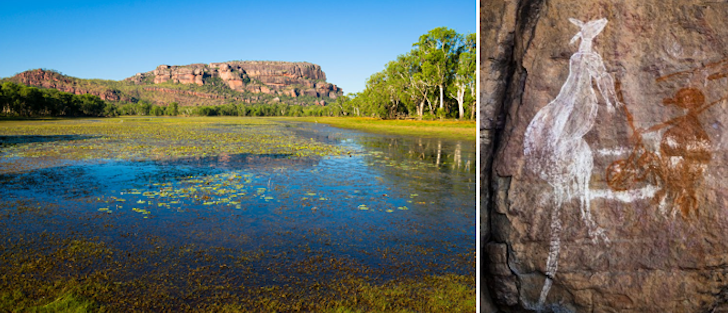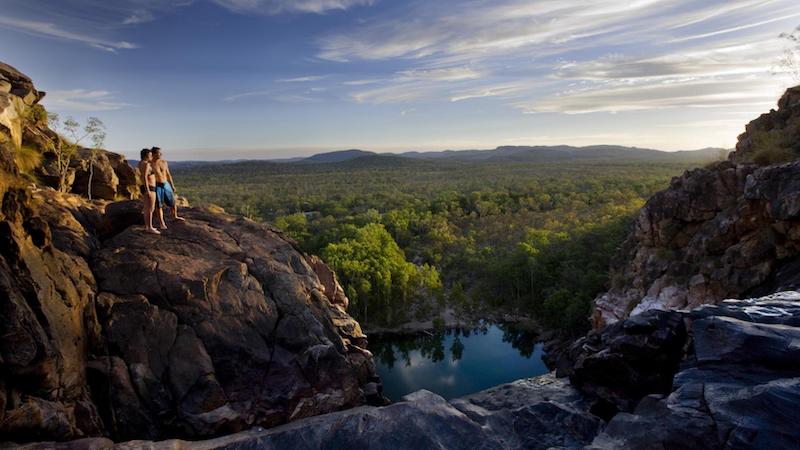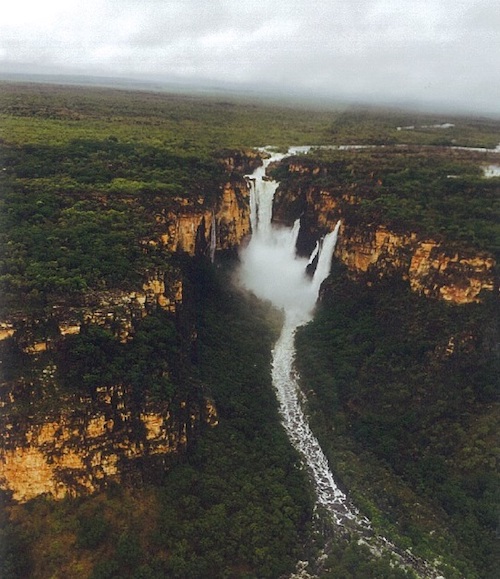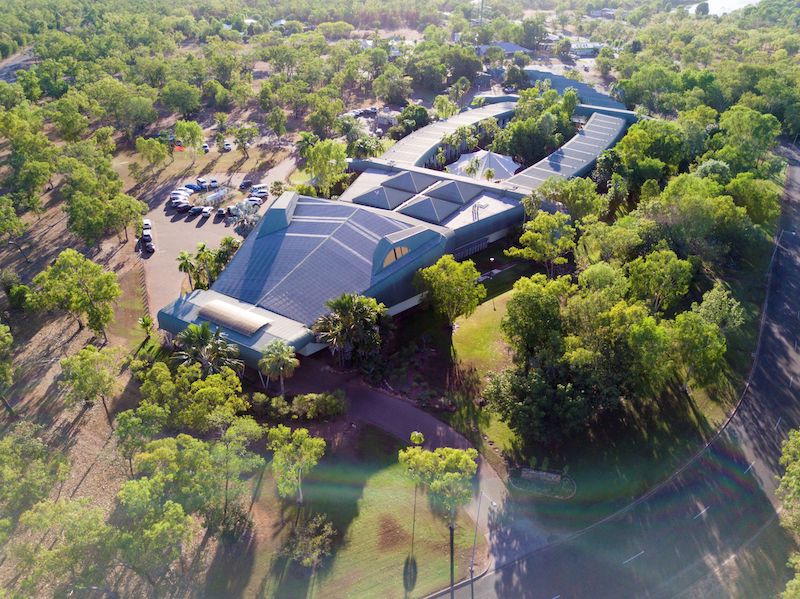Kakadu is frequently mentioned as number one on the travel bucket-list for many Australians. With Northern Territory borders officially re-opening from 17 July, and with bargain airfares announced to Darwin, there’s never been a better time to visit Australia’s most spectacular natural playground. To help you plan for your next adventure, we’ve assembled six tips for your Kakadu visit with the help of Kakadu Tourism.
Paul Hogan brought Kakadu to the world’s attention in Crocodile Dundee, but unlike most winter dry seasons – from April through to October – and this year Australians will have Kakadu National Park to themselves.
Kakadu is best seen over three or four days, or preferably a week, to follow in the footsteps of ‘Hoges’ and experience the dramatic landscape, rich Indigenous culture, surging waterfalls and abundant wildlife.
The ‘dry’ season is actually made up of three seasons, according to Kakadu’s Indigenous calendar, which has been developed over 65,000 years of habitation of the region. Yekke lasts from mid-May to June, Wurrkeng is classified as the “cold weather season” (mid-June to mid-August) but while overnight temperatures might dip to the mid-teens, daytime temperatures usually reach 30C. The dry season finishes with Kurrung from mid-August through October, when millions of magpie geese cover the receding wetlands, along with over 200 other bird species and a vast range of other animals, making it one of the “greatest (natural) shows on earth”.
Kakadu is less than three hours’ drive from Darwin, with fully-sealed roads making travel to and within Kakadu National Park easy, though 4WD vehicles are recommended to ensure visitors can enjoy the full Crocodile Dundee experience.
Six tips for your visit to Kakadu
Kakadu Tip #1 – Stare at the sunset at Ubirr

Ubirr is the rock formation in Kakadu National Park where Mick Dundee climbs to the top, points toward the horizon, and says “This is my backyard, and over there is the Never Never” while the movie camera pans across the flood plain. One of the icons of Kakadu, Ubirr’s rock art galleries contain a remarkable panoramic sweep of history with drawings ranging from the thylacine to the arrival of Europeans. Best time to visit is sunset when the setting sun creates a rich palette of colours on the rock outcrops and the vast Nadab Plain below, where buffalos in their thousands used to roam decades ago.
Kakadu Tip # 2 – Soak up the sunrise on Yellow Water Billabong
A visit to Kakadu must include a Yellow Water Cruise. While crocodiles are always the most prized sighting – and you’re likely to see many of the prehistoric creatures on your cruise – the bird-life is equally awe-inspiring. There are some 260 varieties to spot, from majestic eagles through to the remarkable comb-crested jacana, better known as the ‘Jesus bird’ because of the illusion creates as it seemingly walks on water. The Cruise guides provide expert commentary, with an Indigenous narrative of the heritage, culture, flora and fauna of the wetlands. Cruises operate throughout the year, with sunrise and sunset cruises the most popular.

Tip #3 Look longingly at the legendary rock-art
Nourlangie Rock and the Anbangbang billabong feature heavily in Crocodile Dundee, providing a perfect opportunity for ‘Mick’ Dundee to show American journalist, Sue Charlton, Kakadu’s rich wildlife and his outback ‘skills’. Nourlangie houses some of Kakadu’s most historic rock art. Paintings such as Namarrgon (Lightning Man) explore the relationship of the people to their country and belief. The paintings illustrate the important stories, food sources, wars and mythological figures and can be viewed as part of a 1.5 km circular walk. Free guided walks are offered by Park rangers during much of the year, where you will discover how Indigenous people developed grinding stones for crushing seeds and later used the stones to crush ochre for painting. Climb to the top of the rock for sweeping views of the escarpment, while you can follow in Hoges’ footsteps through the paperbark forest on the Anbangbang Billabong Walk.
Nourlangie Rock and art with Angbangbang Billabong in the foreground

Tip #4 – Marvel at Australia’s most spectacular natural infinity pool
Kakadu tip #4 is located on Waterfall Creek, Gunlom – known as Echo Pool when Paul Hogan and Linda Kozlowski take a swim there in Crocodile Dundee – is a magical combination of waterfall and serene plunge pool, with shady gums cooling the picnic areas. The climb to the top of the waterfall is worth the effort as it offers a series of plunge pools, including an infinity rock pool providing panoramic views across the southern parts of Kakadu National Park. The Gunlom Billabong at the base of the waterfall provides a cool, quiet resting place. A walking route to the top of the falls and lookouts takes approximately one hour over steep terrain and provides sweeping views of the southernmost parts of Kakadu National Park.

Kakadu Tips #5 – Fly like an eagle over Kakadu
During the tropical summer, Kakadu sees torrents of water collect on the Escarpment and pour down the rock faces, creating awesome waterfalls, best viewed from the air. A fixed-wing or helicopter aerial tour of Kakadu is an unforgettable experience, with the experienced pilots able to show you the many locations that starred in the Crocodile Dundee films, including a landing strip which featured in the sequel, where the ‘drug plane’ landed. Unfortunately, in real life, the airstrip proved too short for the plane to take off again!

Tip #6 Catch up with ‘The Croc‘
Crocodiles are, naturally, at the heart of the Crocodile Dundee story, but also the heritage and culture of Kakadu. Known in the local language as ‘ginga’, the crocodile inspired the now world-famous Crocodile Hotel in the township of Jabiru. Fearsome looking from the air, The Croc – as everyone knows it – is far more welcoming once you enter through its jaws, with comfortable rooms, an excellent restaurant serving the best in bush foods, a large cooling swimming pool and native gardens, and Ochre Art Gallery, where local Indigenous artists share their creative talents with guests as they paint intricate works of art.

Where to stay:
There are a few accommodation choices when visiting Kakadu. The Mercure Kakadu Crocodile Hotel is located in Jabiru, the main township of Kakadu. Rooms are available from $159 per night. The Aurora Kakadu hotel is set in attractive, spacious and lush tropical surroundings offering a range of accommodation options from hotel rooms and cabins to shady, grassed camping sites. Cooinda Lodge Kakadu is near the entrance to the Yellow Water Billabong. Cooinda Lodge is in the southern part of Kakadu National Park and offers fully-upgraded Lodge rooms (available from $216 per night), Outback Retreat glamping tents (from $170 per night) and extensive grounds for camping and caravans (from $40 a night). Located next to Yellow Water Billabong and a short drive to the Warradjan Cultural Centre, Cooinda Lodge is a welcoming oasis, with two swimming pools, restaurants, a general store, and petrol station. Bamurru Plains is an extraordinary bush experience on the edge of Kakadu National Park. A nine-room camp exudes ‘Wild Bush Luxury’ bringing a touch of style to a remote and beautiful region.
For accommodation bookings go to https://kakadutourism.com/accommodation. You’ll find all the best accomodation at Kakadu Tourism.
The shorty answer is YES…there’s plenty of camping if you enjoy getting off the beaten track.
You could consider the:
Alligator Billabong camping area which is reached via the track to Red Lily Billabong by 4WD, this campsite is 26 km south of the Arnhem Hwy. There are no facilities, toilets or drinking water.
The Graveside Gorge camping area is a basic bush site and you’ll need to obtain a permit. There are limited facilities and bookings are essential. There are no toilets or other facilities. The track in is suitable for experienced 4WD drivers only. You will find the camping area 44 km south-east of the Kakadu Hwy, with access 73 km south of the Bowali Visitor Centre. The site is sometimes closed to allow for cultural use by Aboriginal traditional owners. The Bucket Billabong camping area is just 2 km past Red Lily Billabong camping area. You will need a 4WD to get into this site.
Burdulba camping area. This camping area is near the turn-off for Nourlangie Rock, which has a number of impressive rock-art sites. Various walks link these sites, and there is also a track to the Nawurlandja Lookout, which gives good views over the surrounding countryside. There is no caravan access to Burdulba, and some campsites require a short carry-in, so are suitable for tents only. You will need to bring drinking water. Look for the sign 15 km south of the Bowali Visitor Centre.
Four Mile Hole camping area This 4WD site may be inaccessible in the wet season and has no toilets or drinking water. To get here, continue past Two Mile Hole for another 22 km.
Garnamarr (Jim Jim Falls) camping area is the closest campsite to the spectacular Jim Jim Falls. It can cater for 200 people, with showers and drinking water. It’s accessible only in the dry season, and is a 60 km journey by 4WD on gravel roads. Turn east off the Kakadu Hwy, 43 km south of the Bowali Visitor Centre.
Black Jungle Springs camping area is another one requiring 4WD to reach this basic site on the Old Jim Jim Rd, which links the Arnhem Hwy to the Kakadu Hwy. There are composting toilets but no drinking water.
Gungurul camping area has year-round access for camping and caravans here. There are picnic tables and toilets but bring your own drinking water and firewood. It is a 4 km bushwalk to the South Alligator River. Access is signposted off the Kakadu Hwy, 47 km north of the Mary River Roadhouse.
Gunlom camping area is one of the best camping spots with access to Gunlom Falls and a swimming hole. There is also a bushwalk to the top of the waterfall if you are keen. Sites are available for generator and non-generator areas, BBQs, hot showers and drinking water. Follow Gunlom Rd for 22 km past the Kambolgie camping area to reach this site. Note: it is on a gravel road so check suitability for 2WD and caravans.
You should always check the road conditions when travelling around Kakadu. Information is available from the Crocodile Hotel or you can get more information right here
If you are staying in accommodation venues, they’re generally well protected from the local crocodiles through appropriate fencing and a range of safety measures. However, if you intend to camp then you’ll need to be “crocwise” Make sure that observe all safety signs and be aware that whenever you are near water in the park, there is a risk of crocs! Camp at least two metres above the high water mark and at least 50 metres from the water’s edge. Camp in designated campsites well away from waterways.
Full information on Kakadu, tours and itineraries: www.kakadutourism.com




















Add Comment